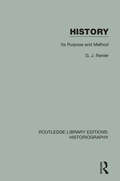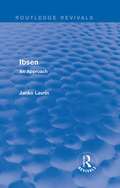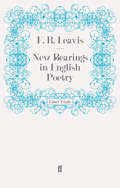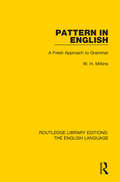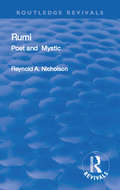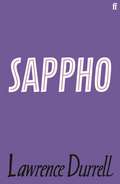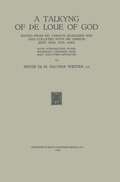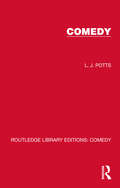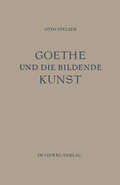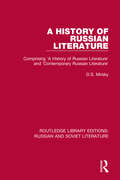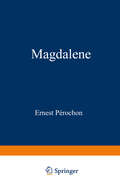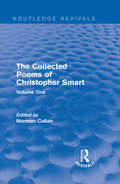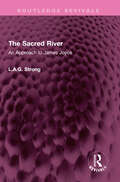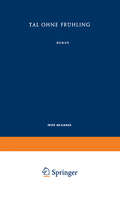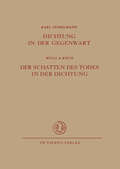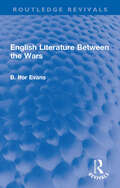- Table View
- List View
History: Its Purpose and Method (Routledge Library Editions: Historiography)
by G. J. RenierThis treatise of historical methodology, originally published in 1950 is based upon a liberal conception of history which excludes no narrator of past events from the ranks of historians. It defines history as the accurate story which preserves the memory of the past experiences of human societies. The functionof history determines its method and provides the answer to the question: how secure is our knowledge of the past? In the author’s view, history is empirical and its results are for ever provisional. The relative merits of dogmatism and scepticism are examined and several interpretations among English historians are scrutinized.
History: Its Purpose and Method (Routledge Library Editions: Historiography)
by G. J. RenierThis treatise of historical methodology, originally published in 1950 is based upon a liberal conception of history which excludes no narrator of past events from the ranks of historians. It defines history as the accurate story which preserves the memory of the past experiences of human societies. The functionof history determines its method and provides the answer to the question: how secure is our knowledge of the past? In the author’s view, history is empirical and its results are for ever provisional. The relative merits of dogmatism and scepticism are examined and several interpretations among English historians are scrutinized.
Ibsen: An Approach (Routledge Revivals)
by Janko LavrinThis book, first published in 1950, could best be described as a combination of literary, psychological and social criticism. Considerable space is allotted to the personal inner drama of Ibsen, which provides not only a clue to his art but shows how most of his themes inevitably grew out of the other. The author also explores some of those factors which make Ibsen of interest to the generation that were facing the social and spiritual havoc of the post-war period. This book will be of interest to students of literature and theatre.
Ibsen: An Approach (Routledge Revivals)
by Janko LavrinThis book, first published in 1950, could best be described as a combination of literary, psychological and social criticism. Considerable space is allotted to the personal inner drama of Ibsen, which provides not only a clue to his art but shows how most of his themes inevitably grew out of the other. The author also explores some of those factors which make Ibsen of interest to the generation that were facing the social and spiritual havoc of the post-war period. This book will be of interest to students of literature and theatre.
New Bearings in English Poetry
by F. R. LeavisIt is difficult now to imagine the shock that this book caused when it was first published in 1932. The author was a teacher at a Cambridge college, an intensely serious man who had been seriously wounded by poison gas on the Western Front, and he was not disposed to suffer foolishness gladly. His opening sentences were arresting: 'Poetry matters little to the modern world. That is, very little of contemporary intelligence concerns itself with poetry'. What followed was nothing less than the welcoming of a revolution in English verse, set against the moral and social crisis that followed the trauma of the First World War. It was this situation, this feeling of breakdown and disorder, that gave such force to Leavis's dismissal of most late Romantic poetry and his welcoming of the modernists T. S. Eliot and Ezra Pound, and of the writer who Leavis regarded as their forebear, Gerard Manley Hopkins. The tone of high moral urgency, and the message that the experience of literature could become an engagement with life that was almost a secular equivalent to religion, seemed new and abrasively refreshing. Leavis despised the reigning dilettantism in both poetry and criticism, and in this book he threw down the gauntlet to the establishment as he understood it. In the same year he founded the journal Scrutiny, and began his long career as the most formidably serious literary critic of his time.
Pattern in English: A Fresh Approach to Grammar (Routledge Library Editions: The English Language)
by W. H. MittinsThis book, first published in 1950, is a collection of what the author felt to be the minimum of English grammar relevant to efficient communication in language. The scope of this title was determined by collecting from children’s writings examples of common faults and weaknesses, and it is through these texts that certain concepts emerged as fundamental, including predication, word-order, proximity, equivalents, variety and repetition. Pattern in English will be of interest to students of English language.
Pattern in English: A Fresh Approach to Grammar (Routledge Library Editions: The English Language)
by W. H. MittinsThis book, first published in 1950, is a collection of what the author felt to be the minimum of English grammar relevant to efficient communication in language. The scope of this title was determined by collecting from children’s writings examples of common faults and weaknesses, and it is through these texts that certain concepts emerged as fundamental, including predication, word-order, proximity, equivalents, variety and repetition. Pattern in English will be of interest to students of English language.
Revival: Selections from his Writings, Translated from the Persian with Introduction and Notes (Routledge Revivals)
by Maulana Jalāl al-Dīn RūmīTo the English reader the mysticism of Rumi opens a new world of spiritual and poetical experience. "God is One but religions are many" runs the Sufi teaching; and the English reader can here enlarge his experience by apprehending the mystic intuition of a great Persian poet. The late author's beautiful and faithful translations are illuminated by Notes on Sufi doctrine and experience. The author did not finish the Introduction, but it has been completed by his old pupil and friend, Professor A. J. Arberry, who has seen the book through the press.
Revival: Selections from his Writings, Translated from the Persian with Introduction and Notes (Routledge Revivals)
by Maulana Jalāl al-Dīn RūmīTo the English reader the mysticism of Rumi opens a new world of spiritual and poetical experience. "God is One but religions are many" runs the Sufi teaching; and the English reader can here enlarge his experience by apprehending the mystic intuition of a great Persian poet. The late author's beautiful and faithful translations are illuminated by Notes on Sufi doctrine and experience. The author did not finish the Introduction, but it has been completed by his old pupil and friend, Professor A. J. Arberry, who has seen the book through the press.
Sappho
by Lawrence Durrell'A magician.' The Times'A philosophical play of ideas, exploring loss, war, and incest in Ancient Greece, by the celebrated author of The Alexandria Quartet.Lesbos, Ancient Greece. Lawrence Durrell's intricate play follows vivid characters who represent different attitudes towards the role of the individual in the world, exploring how their lofty ideals are transformed when they become victims of unforeseeable real-life circumstances. Eloquent, tragic, poetic, Durrell's parable is a powerful study of idealism in an imperfect universe, drawing vibrant parallels between the classical world and our modern existence.
The Theban Plays (Penguin Classics): (pdf)
by Sophocles E. F. Watling (Translator Introduction‘O Light! May I never look on you again, Revealed as I am, sinful in my begetting, Sinful in marriage, sinful in shedding of blood!’ The legends surrounding the royal house of Thebes inspired Sophocles (496–406 BC) to create a powerful trilogy of mankind’s struggle against fate. King Oedipus tells of a man who brings pestilence to Thebes for crimes he does not realise he has committed, and then inflicts a brutal punishment upon himself. With profound insights into the human condition, it is a devastating portrayal of a ruler brought down by his own oath. Oedipus at Colonus provides a fitting conclusion to the life of the aged and blinded king, while Antigone depicts the fall of the next generation, through the conflict between a young woman ruled by her conscience and a king too confident in his own authority. E. F. Watling’s masterful translation is accompanied by an introduction, which examines the central themes of the plays, the role of the Chorus, and the traditions and staging of Greek tragedy. For more than seventy years, Penguin has been the leading publisher of classic literature in the English-speaking world. With more than 1,700 titles, Penguin Classics represents a global bookshelf of the best works throughout history and across genres and disciplines. Readers trust the series to provide authoritative texts enhanced by introductions and notes by distinguished scholars and contemporary authors, as well as up-to-date translations by award-winning translators.
Comedy: The European Heritage (Routledge Library Editions: Comedy)
by L. J. PottsOriginally published in 1949 this book is a study of comedy based on representative works of drama and narrative, mainly in English, from Chaucer to Bernard Shaw. The theme is that comedy implies a philosophy of life that is fairly constant, despite the changes in social conditions and fashions of thought. There is a bibliographical index and the book is illustrated fully and widely by quotations from English comic writers.
Comedy (Routledge Library Editions: Comedy)
by L. J. PottsOriginally published in 1949 this book is a study of comedy based on representative works of drama and narrative, mainly in English, from Chaucer to Bernard Shaw. The theme is that comedy implies a philosophy of life that is fairly constant, despite the changes in social conditions and fashions of thought. There is a bibliographical index and the book is illustrated fully and widely by quotations from English comic writers.
A History of Russian Literature: Comprising 'A History of Russian Literature' and 'Contemporary Russian Literature' (Routledge Library Editions: Russian and Soviet Literature #6)
by D.S. MirskyThis book, first published in 1949, is an abridged version of Mirsky’s classic two texts on Russian literature, updated with a postscript by the editor assessing the development of Soviet literature. Beautifully written, Mirsky’s analyses of Russian writers and literature go hand in hand with his takes on Russian history. From the birth of Russian literature to its Soviet form, this book is a lively and comprehensive examination by one of its leading scholars.
A History of Russian Literature: Comprising 'A History of Russian Literature' and 'Contemporary Russian Literature' (Routledge Library Editions: Russian and Soviet Literature #6)
by D.S. MirskyThis book, first published in 1949, is an abridged version of Mirsky’s classic two texts on Russian literature, updated with a postscript by the editor assessing the development of Soviet literature. Beautifully written, Mirsky’s analyses of Russian writers and literature go hand in hand with his takes on Russian history. From the birth of Russian literature to its Soviet form, this book is a lively and comprehensive examination by one of its leading scholars.
Routledge Revivals (1949): Volume One
by Christopher SmartFirst published in 1949, this book presents the collected works of Christopher Smart, the eighteenth-century poet whose life has an attraction for the curioso of literature. There is the early marriage with Anne Vane, his secret marriage, eighteenth-century Cambridge life, the intrigues of Grub Street, and, finally, insanity and confinement in an asylum. Smart remains a strange, enigmatic figure, repulsive or attractive according to the temperament of the investigator. His poetry is not easy to disentangle from his character – egocentric, given to exhibitionism, childish, oscillating between the extremes of self-belittlement and self-glorification; but he has his own claim to fame. Few other poets match him in directness of expression. He is a poet with the eye of a painter, developed in an unusually high degree. He has a stereoscopic vision which makes the object leap to the eye, the painter’s sense of physical texture and his skill in composing a picture. Then again, there is his versatility. He practised almost every kind of poetry and gave to each kind his own personal inflection. It is the aim of this edition to present as complete a text as possible in the way that Smart himself would have seen it and, in giving some account of the poet’s life, to link his poetry with it. The book will be of interest to students of eighteenth-century literature and history.
Routledge Revivals (1949): Volume One
by Christopher SmartFirst published in 1949, this book presents the collected works of Christopher Smart, the eighteenth-century poet whose life has an attraction for the curioso of literature. There is the early marriage with Anne Vane, his secret marriage, eighteenth-century Cambridge life, the intrigues of Grub Street, and, finally, insanity and confinement in an asylum. Smart remains a strange, enigmatic figure, repulsive or attractive according to the temperament of the investigator. His poetry is not easy to disentangle from his character – egocentric, given to exhibitionism, childish, oscillating between the extremes of self-belittlement and self-glorification; but he has his own claim to fame. Few other poets match him in directness of expression. He is a poet with the eye of a painter, developed in an unusually high degree. He has a stereoscopic vision which makes the object leap to the eye, the painter’s sense of physical texture and his skill in composing a picture. Then again, there is his versatility. He practised almost every kind of poetry and gave to each kind his own personal inflection. It is the aim of this edition to present as complete a text as possible in the way that Smart himself would have seen it and, in giving some account of the poet’s life, to link his poetry with it. The book will be of interest to students of eighteenth-century literature and history.
The Sacred River: An Approach to James Joyce (Routledge Revivals)
by L.A.G. StrongFirst Published in 1949, The Sacred River attempts to present a survey of James Joyce’s work. In 1932 Mr Strong published an essay in the course of which he suggested that Work in Progress was the first full scale application to the novel of twentieth century ideas on space and time, demanding from the reader a radical change in practice. The essay was read by Joyce, and the theory subsequently confirmed. From that point Mr Strong has continued his study of Joyce. This work is limited to four main lines of approach: interest in singing and singers, a passion with Joyce; literature, in particular Shakespeare, Swift, Blake, and the Romantic Movement, of which the author believes Finnegans Wake to be the logical fulfilment; contemporary theories of psychology; and Christian metaphysics. Mr Strong’s first-hand acquaintance with Dublin in the early nineteen-hundreds has been a further help, as was his friendship with Yeats, A.E., and other Irish writers who knew Joyce personally. The result is a stimulating and provocative piece of criticism, of which we may safely say that it outruns its modest programme. This book is a must read for scholars and researchers of English literature.
The Sacred River: An Approach to James Joyce (Routledge Revivals)
by L.A.G. StrongFirst Published in 1949, The Sacred River attempts to present a survey of James Joyce’s work. In 1932 Mr Strong published an essay in the course of which he suggested that Work in Progress was the first full scale application to the novel of twentieth century ideas on space and time, demanding from the reader a radical change in practice. The essay was read by Joyce, and the theory subsequently confirmed. From that point Mr Strong has continued his study of Joyce. This work is limited to four main lines of approach: interest in singing and singers, a passion with Joyce; literature, in particular Shakespeare, Swift, Blake, and the Romantic Movement, of which the author believes Finnegans Wake to be the logical fulfilment; contemporary theories of psychology; and Christian metaphysics. Mr Strong’s first-hand acquaintance with Dublin in the early nineteen-hundreds has been a further help, as was his friendship with Yeats, A.E., and other Irish writers who knew Joyce personally. The result is a stimulating and provocative piece of criticism, of which we may safely say that it outruns its modest programme. This book is a must read for scholars and researchers of English literature.
English Literature Between the Wars (Routledge Revivals)
by B. Ifor EvansFirst published in 1948, English Literature Between the Wars sets out to answer a question: to what extent did the years between the two wars constitute a period in literature? Its exploration leads the author to assess the changes in the reading public, and in the movement of taste. He is led to the conclusion that in the inter-war period some writers were aware that a crisis in civilization was taking place and that these were the more genuinely creative writers. Apart from a consideration of these general problems, the volume contains studies of E.M. Forster, James Joyce, Aldous Huxley, D. H. Lawrence, Virginia Woolf, and others. It also assesses the influence of war on the literature of the period, comments on the work of the younger writers, and adds a note on the theatre. Students of literature and history will find this book particularly interesting.
